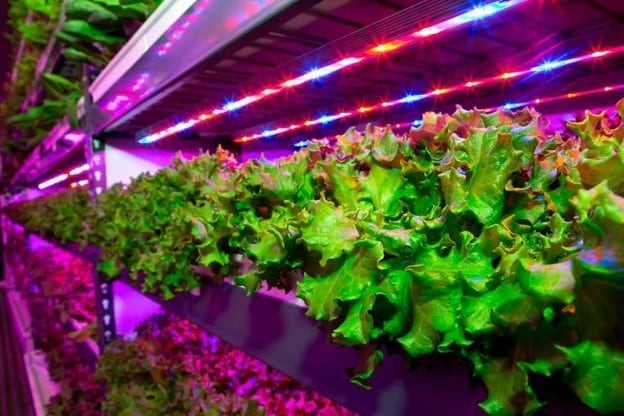Emirates is building a giant vertical farm to feed airline passengers

Growing conditions are controlled digitally. Image: REUTERS/Rafael Marchante

Get involved with our crowdsourced digital platform to deliver impact at scale
Stay up to date:
Emerging Technologies
The world’s largest vertical farm is coming to Dubai.
The indoor farm is a $40 million joint venture between Crop One Holdings and Emirates Flight Catering, who say it’s a way of producing pesticide-free crops while using a fraction of the water that traditional farming does.
The produce will feed passengers of Emirates and other airlines at Dubai’s Al Maktoum International Airport. The farm will be built near the airport, eliminating trucking costs and emissions.
But is vertical farming really as green as it seems?

How does it work?
To feed a growing global population – which could reach 9.1 billion by 2050 – world food production will need to rise by 70%.
In addition, most of us will be living in cities, and will likely want to source our food locally.
Many think that vertical farms offer a viable solution.
For one thing, this type of farming doesn’t need soil. The plants are stacked on top of each other in rows, their roots immersed in nutrient-rich water. This system – called hydroponics – uses 99% less water than field farming. The plants sit under LED lights which drive their photosynthesis.
The growing conditions are controlled digitally. The temperature, humidity, light, water and plant nutrients are all monitored by a computer, which constantly adjusts the levels according to what the plants need.
This also means that the farms can be set up anywhere, as long as there’s a source of electricity and access to distilled water. In the future we may see these farms on offshore oil and gas exploration facilities and in extreme climates.
In the new Dubai facility, the plants are stacked together four or five storeys high over 130,000 square feet (12,077 square metres). That’s enough space to grow greens for the 225,000 meals that Emirates Flight Catering produce daily.
The benefits
Proponents of vertical farming argue that the benefits are many. There’s no need for great swathes of land to grow food. Crop One says that the facility will produce the same amount on a single acre indoors that would normally require 400 acres of land. In addition, the food can be grown in cities, leaving redundant agricultural land to be taken back by nature.
No fertilizers or pesticides are used, so there is no agricultural runoff – one of the main sources of pollutants in our waterways. However, critics argue that the energy costs can be high.
Bruce Bugbee, a professor of crop physiology at Utah State University, says that even the best LED lights only have a 50% efficiency rate. “Transportation costs account for about 4% of the energy in the food system. The energy for electric lights is much greater than that,” he told The New York Times.
In addition, so far only a few types of crops are suitable for indoor farming, such as lettuces and tomatoes.
It’s catching on
But it’s enough of an idea to interest investors, who are pouring millions into the start-ups revolutionizing the way we grow food.
The global vertical farming market was valued at $1.5 billion in 2016, and the hydroponics segment contributed nearly 42%.
According to research firm Allied Market Research, the global vertical farming market is expected to reach $6.4 billion by 2023.
Don't miss any update on this topic
Create a free account and access your personalized content collection with our latest publications and analyses.
License and Republishing
World Economic Forum articles may be republished in accordance with the Creative Commons Attribution-NonCommercial-NoDerivatives 4.0 International Public License, and in accordance with our Terms of Use.
The views expressed in this article are those of the author alone and not the World Economic Forum.
The Agenda Weekly
A weekly update of the most important issues driving the global agenda
You can unsubscribe at any time using the link in our emails. For more details, review our privacy policy.
More on Emerging TechnologiesSee all
Ella Yutong Lin and Kate Whiting
April 23, 2024
Andre S. Yoon and Kyoung Yeon Kim
April 23, 2024
Simon Torkington
April 23, 2024
Thong Nguyen
April 23, 2024
Kalin Anev Janse and José Parra Moyano
April 22, 2024
Sebastian Buckup
April 19, 2024







